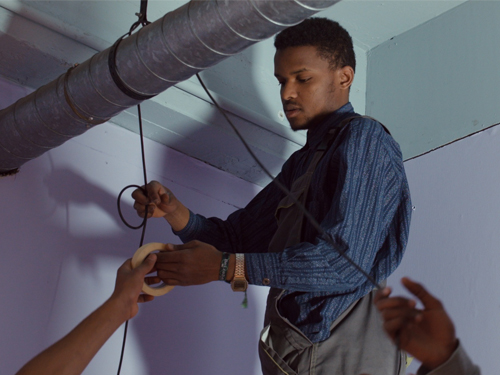
Grands travaux is set in the Institute Anneessens-Funck, a Dutch-speaking vocational school in the centre of Brussels where young students have come to learn a trade. The film both documents and stages that which gives shape to their lives: the practical assignments and classes at school, football, the oscillation of their love lives, as well as the ongoing search for housing and employment. Depicting daily life within the school walls, Grands travaux also aims to sketch an image of Brussels today, placing its youngsters at the very centre.1
EN
Bjorn Gabriels: It’s also striking that you don’t take the bird’s-eye view you’ve mentioned earlier, or include the perspective of various educational or social experts. You shoot from within the intimacy of these boys’ lives.
Gerard-Jan Claes: We wanted to find an intimacy with the boys. We could only attain it through the way we shot our film, but also because after a while they allowed us into their daily lives.
Olivia Rochette: The form of the film is partly guided by the youngsters themselves too. Grands travaux focuses on everyday actions of individual boys. Moments like these are usually omitted from films because of the need to zero in on conflict and the development of a storyline. This reminds me once more of Johan van der Keuken, for whom a film consists of images shot when you come into contact with reality, and not as an illustration of what you already knew in advance.
[...]
Gerard-Jan Claes: Grands travaux might be considered a tentative cartography of the vocational school Anneessens-Funck. We mapped the various spaces of a place where the fragments of a disintegrated city converge. Just like with Because We Are Visual and Rain, constructing Grands travaux was closely related to a tension between inside and outside, between private and public space, between darkness and light... Essentially, Grands travaux is about how we might create new spaces in film. It’s a flowing geography, a movement through the polymorphous spaces inhabited by the boys.
Bjorn Gabriels in conversation with Olivia Rochette and Gerard-Jan Claes1
- 1Olivia Rochette and Gerard-Jan Claes, “Grands travaux. Interview with Olivia Rochette and Gerard-Jan Claes,” Sabzian, 11 January 2017.
NL
Bjorn Gabriels: Daarbij valt ook op dat jullie niet het al eerder vermelde vogelperspectief innemen of inzetten op standpunten van allerlei experts in onderwijs en sociale zaken. Jullie filmen vanuit de intieme levenssfeer van de jongens.
Gerard-Jan Claes: We wilden een intimiteit vinden met de jongens. Die krijg je niet alleen door de wijze waarop je filmt, maar ook doordat ze ons na een tijdje toelieten in hun leefwereld.
Olivia Rochette: De vorm die de film krijgt, wordt mee gestuurd door de jongeren zelf. Grands travaux focust op alledaagse handelingen uit het leven van individuele leerlingen. Momenten als deze worden meestal weggelaten uit films vanuit de behoefte om zich toe te spitsen op conflicten of de ontwikkeling van een verhaallijn. Daarbij denk ik opnieuw aan Johan van der Keuken, voor wie een film bestaat uit beelden gefilmd tijdens je contact met de werkelijkheid en niet vanuit wat je er vooraf al over dacht.
[...]
Gerard-Jan Claes: Je zou Grands travaux kunnen beschouwen als een poging tot cartografie van de beroepsschool Anneessens-Funck. We brengen al de verschillende ruimtes in kaart van een plek waar de Brusselse verbrokkeling convergeert. Net als bij Because We Are Visual en Rain is de opbouw van Grands travaux sterk verbonden aan een spanningsveld tussen binnen en buiten, tussen private en openbare ruimte, tussen donker en licht … In se gaat Grands travaux over hoe we in film nieuwe ruimtes kunnen creëren. De film is een vloeiende geografie, een beweging door de veelvormige leefruimtes van de jongeren.
Bjorn Gabriels in gesprek met Olivia Rochette en Gerard-Jan Claes1
- 1Olivia Rochette en Gerard-Jan Claes, “Grands travaux. Interview met Olivia Rochette en Gerard-Jan Claes,” Sabzian, 11 januari 2017
FR
Olivia Rochette: Sans qu’on ne doive leur expliquer quoi que ce soit, Barry, Mamadou, Achmed et Abdi ont très vite compris ce qu’on recherchait. Au fur et à mesure, nous avons tous compris quel ton ou quel rythme il fallait adopter pour le film. La rencontre de ces jeunes garçons a été décisive dans le processus du tournage. Ils étaient vraiment spéciaux et très ouverts, du fait de leur jeune âge aussi. Le contact avec les élèves plus âgés était plus difficile.
Gerard-Jan Claes: Grands travaux joue avec une certaine mise en scène, mais le point de départ reste cependant l’observation. Nous ne voulons pas que la forme soit dictée par une idée, mais essayons de prendre comme point de départ les gens et les endroits que nous rencontrons. Il s’agit donc d’un cinéma documentaire. Souvent, on trouve la distinction entre cinéma et documentaire redondante. Ainsi, le cinéaste Johan van der Keuken disait : « La lumière sur l’écran est toujours fictive. » Mais pour nous, il y a quand même une différence en ce que la tension dans le cinéma documentaire est tout à fait différente. Van der Keuken en était pleinement conscient. À la fin de son deuxième film Herman Slobbe (1966), qui traite d’enfants aveugles, il rend cette tension explicite. Quand il quitte le garçon Slobbe, Van der Keuken dit en voix off: « Tout dans le film est forme. Herman est une forme. Au revoir, gentille forme. » Cette tension entre réalité et forme est inhérente au cinéma documentaire. Le cinéma fictif par contre, ne joue pas avec cette tension et répond selon nous à d’autres enjeux.
Bjorn Gabriels en conversation avec Olivia Rochette et Gerard-Jan Claes1
- 1Olivia Rochette et Gerard-Jan Claes, « Filmmagie a rencontré les réalisateurs de Grands travaux, Gerard-Jan Claes et Olivia Rochette ».

